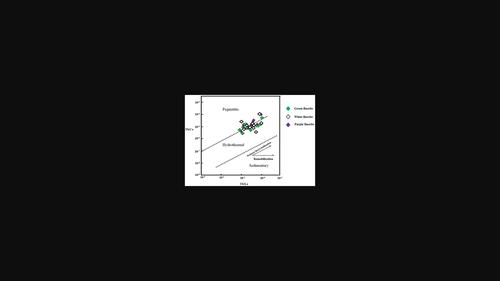Trace element composition of fluorite from the Chumathang pegmatite deposit, eastern Ladakh, India
IF 0.8
4区 地球科学
Q3 GEOLOGY
引用次数: 0
Abstract
The fluorite deposit of the Chumathang area of south-eastern Ladakh, India, is hosted in pegmatite which cross-cuts the Paleogene Chumathang granite. The rare earth element and yttrium (REE-Y) and the trace element's composition of different colored (green, purple, and white) fluorite were investigated to understand its genesis. The green fluorite core is surrounded by purple fluorite, indicating that green fluorite crystallized earlier than the purple one. The white fluorite is mineralized with green fluorite, it does not exhibit any zoning like the other fluorite. The REE pattern of green and white fluorites is similar to those in the host pegmatite and associated Chumathang granite. ƩREE content in fluorite increases from green, white to purple. Fluorites in the study area are characterized by negative Ce suggesting partial reducing conditions during its formation. The Y/Y*, Ce/Ce*, and Eu/Eu* ratios show that fluorite records the compositional evolution of the hydrothermal solutions that transported the trace and REE from the host granite during the fluid–wall rocks interactions. The fluorite exhibits a positive Y anomaly which is suggestive of strong Y-Ho fractionation in the fluid system. Chumathang fluorite show significant degrees of differentiation between terbium (Tb) and lanthanum (La) in all the purple, green, and white colored fluorite. The Tb/La and Tb/Ca ratios of the fluorites confirm the role of pegmatitic melt and hydrothermal fluid in the genesis of Chumathang fluorite.

印度拉达克东部楚马唐伟晶岩矿床萤石微量元素组成
印度拉达克东南部楚马唐地区的萤石矿床赋存于与古近系楚马唐花岗岩交叉的伟晶岩中。研究了不同颜色(绿、紫、白)萤石的稀土元素、钇(REE-Y)及微量元素组成,了解其成因。绿色萤石芯被紫色萤石包围,说明绿色萤石比紫色萤石更早结晶。白色萤石与绿色萤石矿化,不像其他萤石一样表现出任何分带。绿、白萤石的稀土元素模式与寄主伟晶岩及其伴生的楚马塘花岗岩相似。ƩREE萤石的含量由绿色、白色到紫色逐渐增加。研究区萤石具有负Ce特征,表明其形成过程中存在部分还原条件。Y/Y*、Ce/Ce*和Eu/Eu*比值表明,萤石记录了流体-围岩相互作用过程中从寄主花岗岩输送微量元素和稀土元素的热液组分演化过程。萤石呈正Y异常,提示流体体系中存在强Y- ho分馏作用。楚马唐萤石在所有紫色、绿色和白色萤石中都表现出明显的铽(Tb)和镧(La)分化。萤石的Tb/La和Tb/Ca比值证实了伟晶岩熔体和热液在楚马塘萤石成因中的作用。
本文章由计算机程序翻译,如有差异,请以英文原文为准。
求助全文
约1分钟内获得全文
求助全文
来源期刊

Resource Geology
地学-地质学
CiteScore
2.30
自引率
14.30%
发文量
18
审稿时长
12 months
期刊介绍:
Resource Geology is an international journal focusing on economic geology, geochemistry and environmental geology. Its purpose is to contribute to the promotion of earth sciences related to metallic and non-metallic mineral deposits mainly in Asia, Oceania and the Circum-Pacific region, although other parts of the world are also considered.
Launched in 1998 by the Society for Resource Geology, the journal is published quarterly in English, making it more accessible to the international geological community. The journal publishes high quality papers of interest to those engaged in research and exploration of mineral deposits.
 求助内容:
求助内容: 应助结果提醒方式:
应助结果提醒方式:


